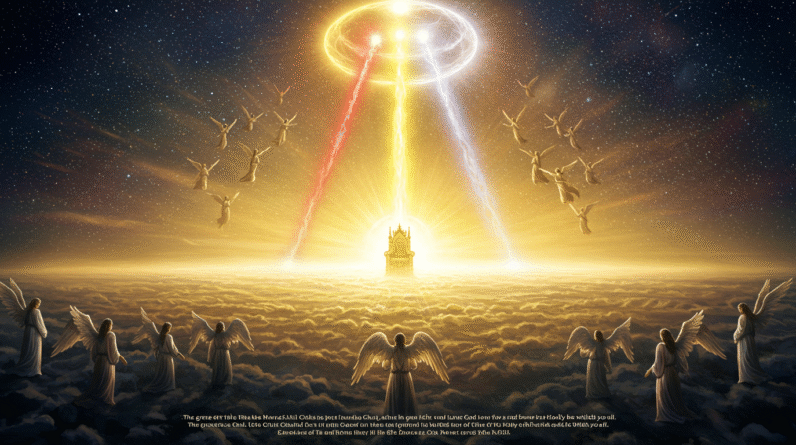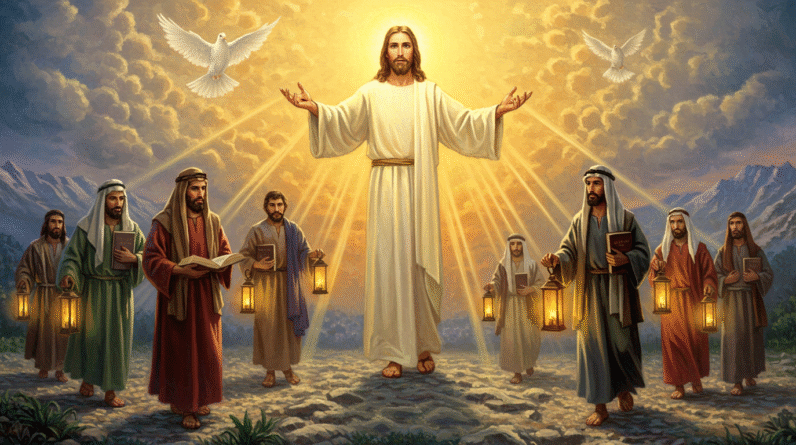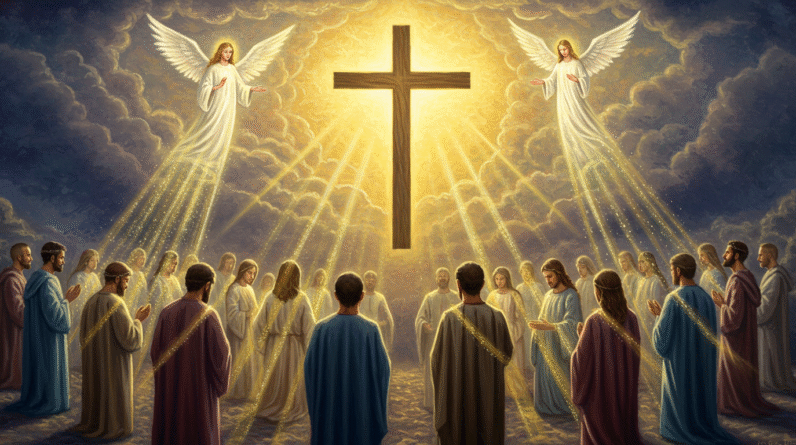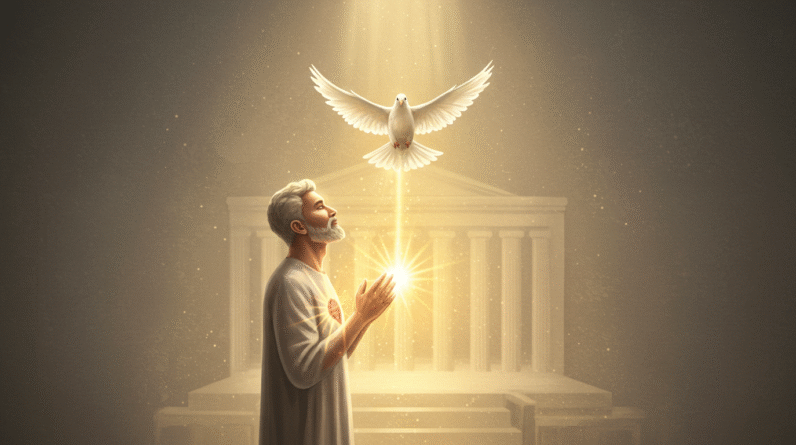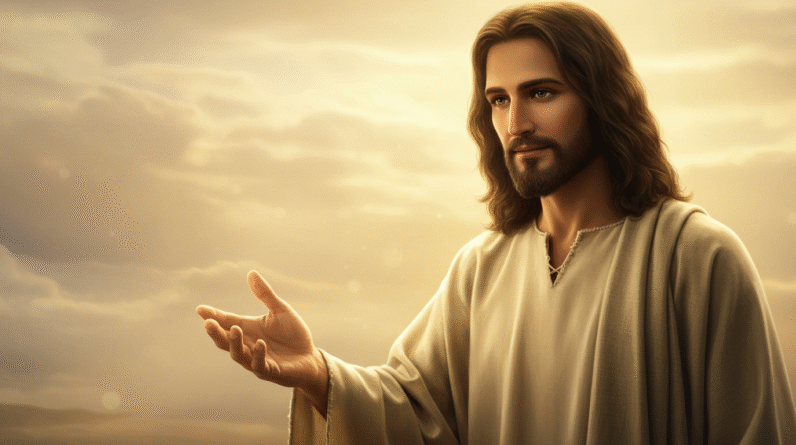The Trinity in Jesus’ Baptism (Matthew 3:16–17)
You’re standing on the banks of the Jordan River, watching a moment unfold that will echo through eternity. In Matthew 3:16–17 you see Jesus, the Son, undergoing baptism; you hear the voice of the Father from heaven; you witness the Holy Spirit descending like a dove. This brief scene is one of the clearest windows Scripture gives you into the mystery of the Trinity — one God revealed in three distinct Persons. As you read these verses, you’re invited to see not only a historical event but a theological revelation that shapes how you relate to God in worship, prayer, and daily life. Read the passage here: Matthew 3:16–17.
The scene at the Jordan: what actually happened
When you read Matthew’s account, you see three distinct actions happening simultaneously: Jesus comes up out of the water, the heavens open, the Spirit of God descends like a dove and lands on him, and a voice from heaven declares, “This is my Son, whom I love; with him I am well pleased.” That sequence presents all three Persons of the Godhead acting in a single, decisive event. As you picture the moment, consider that God is not a distant abstraction; He is personally present and personally involved — Father, Son, and Spirit — each engaging in the work of salvation and revelation. See the full context around Jesus’ baptism in Matthew 3:13–17 here: Matthew 3:13–17.
Why this moment reveals the Trinity so clearly
If you’re looking for a picture of the Trinity in Scripture, Jesus’ baptism is one of the clearest. Here you have the Son being baptized, the Spirit descending, and the Father speaking. These are not interchangeable roles or mere modes of God’s activity; they are distinct Persons interacting. The Father speaks, the Son submits to baptism, and the Spirit descends. Together, they reveal one God acting in harmonious purpose. This visible, audible, and tangible revelation helps you understand that the Bible insists on both the oneness of God and the personal distinctions within the Godhead — a truth Jesus’ baptism makes plain. Read another parallel on the same event in Luke: Luke 3:21–22.
The Son: Jesus submits humbly to baptism
Jesus’ humility and solidarity with sinners
When you watch Jesus step into the Jordan to be baptized, you might ask, “Why would the sinless Son of God need baptism?” Matthew records His words to John: He came “to fulfill all righteousness” (Matthew 3:15). Jesus’ baptism was not an act of repentance for Himself — the Scriptures make clear that He was without sin — but it was a gesture of identification with you and with sinful humanity. By submitting to baptism, He announces publicly His mission and aligns Himself with the people He came to save. This teaches you that God’s love involves humility and solidarity. Read Jesus’ exchange with John, which explains the reason for His baptism: Matthew 3:13–15.
The Son as the obedient Servant
You also see here the obedience of the Son to the Father’s plan. Throughout the Gospels, Jesus steps toward the cross in quiet submission. His baptism prefigures that path of obedience. He accepts the Father’s will and begins the public work that will culminate in atonement and resurrection. Hebrews helps you grasp the Son’s faithful obedience: He is a high priest who can sympathize with your weaknesses yet was tempted without sin (see Hebrews 4:15). The baptism is an outward sign of an inward obedience that defines His mission.
The Spirit: the descent like a dove
A visible sign with spiritual significance
As you read, the Spirit of God descends “like a dove” and rests on Jesus (Matthew 3:16). That image carries both symbolic and real significance. The dove suggests gentleness, peace, and purity, but it is not merely decorative — it is the actual anointing of Jesus for His mission. The Spirit’s descent marks Jesus as the One empowered for ministry, the Messiah who will teach, heal, and ultimately conquer sin and death. John the Baptist later testifies that he saw the Spirit come down and remain on Jesus, confirming Him as God’s chosen One: John 1:32–34.
The Spirit’s role: empowering and testifying
The Spirit’s action at the baptism shows you one of His vital roles: to empower and to testify. The Spirit anoints Jesus for ministry, enabling His proclamation of the kingdom and His works of power. In Acts, Peter describes how God anointed Jesus with the Holy Spirit and power, confirming His ministry among you: Acts 10:38. This same Spirit now works in you to bring life, conviction, and transformation. Romans says that the Spirit who raised Jesus from the dead lives in you and will give life to your mortal bodies (see Romans 8:11). In the baptism of Jesus, the Spirit’s presence signals that the work of redemption is a Spirit-enabled mission from beginning to end.
The Father: the voice from heaven
Divine approval and declaration
When the Father speaks, you hear an unmistakable affirmation: “This is my Son, whom I love; with him I am well pleased” (Matthew 3:17). That voice from heaven confirms Jesus’ identity and mission. It is the Father’s public endorsement of the Son, a heavenly confirmation that echoes earlier promises and prophecies. Theologically, the Father’s declaration shows you relational love within the Godhead: the Father loves the Son, and that love is shared with humanity through the Son’s mission. You can read the declaration again: Matthew 3:16–17.
Echoes of covenantal sonship
The Father’s voice also has Old Testament resonances that deepen your understanding. Psalm 2:7 proclaims, “You are my son; today I have become your father,” and Isaiah’s servant passages speak of God’s chosen one who delights in His Spirit (see Psalm 2:7; Isaiah 42:1). These echoes link Jesus’ baptism to God’s ancient promises and show you that the Father’s voice is not only validation but fulfillment of covenant hope.
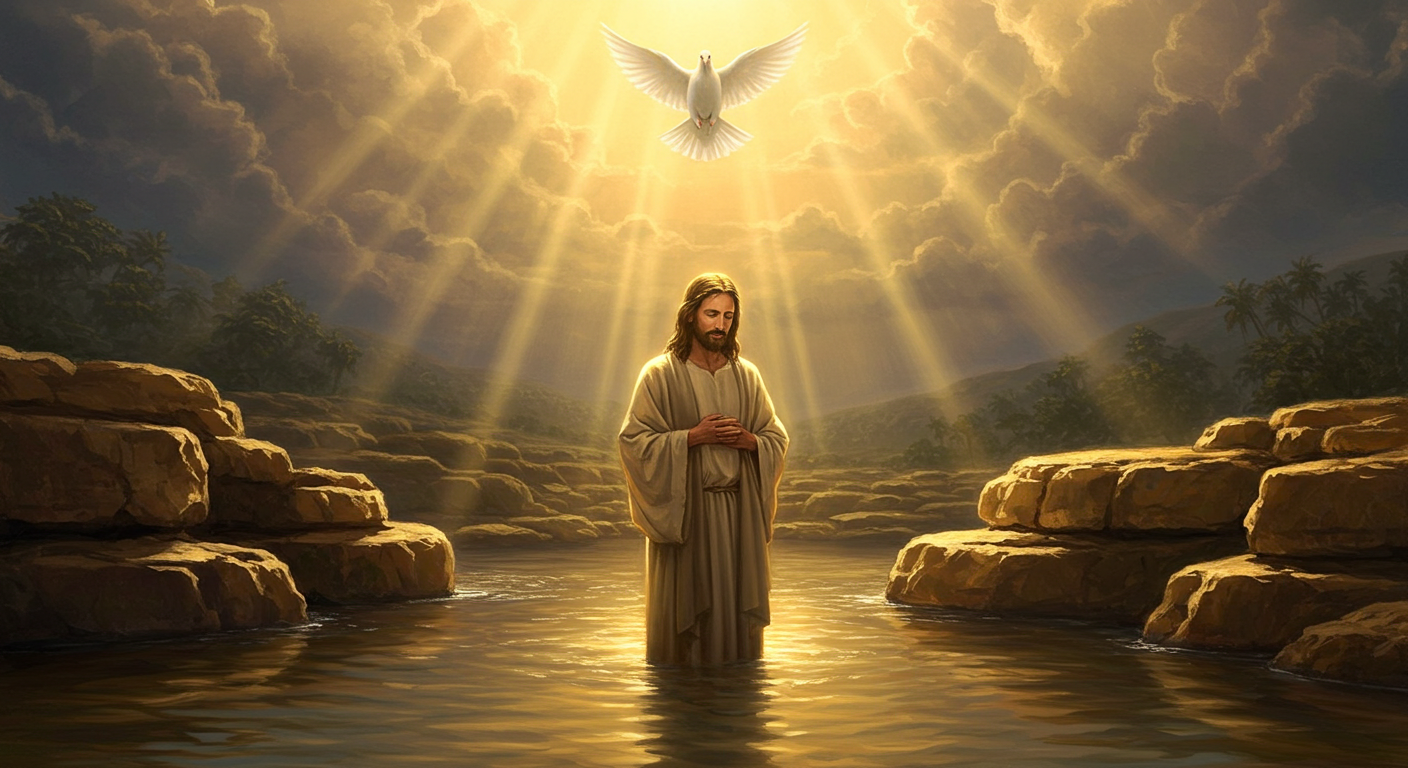
The Trinity: one God in three Persons
Biblical language that supports both unity and distinction
You might wonder how Scripture can speak of God as one and yet reveal three Persons. Matthew 3:16–17 gives you both unity and distinction in a single moment. The New Testament elsewhere makes the doctrine explicit: Jesus commissions his disciples in the name of the Father, the Son, and the Holy Spirit in Matthew 28:19, and Paul’s blessing invokes all three in 2 Corinthians 13:14. These texts instruct you: the Father, Son, and Spirit are distinct Persons, yet they share the one divine name and the one divine essence. Read the baptismal commission: Matthew 28:19. Read Paul’s Trinitarian blessing: 2 Corinthians 13:14.
How biblical portraits build a coherent doctrine
You’ll not find the term “Trinity” spelled out in a single verse of the Bible, but you do find a consistent revelation that leads to the doctrine. John opens with God’s Word being with God and being God (see John 1:1–3), later identifying that Word as Jesus. The Spirit is presented as distinct, active, and divine throughout the New Testament, and the Father remains the ultimate source and speaker. As you weave these biblical threads together, you develop a coherent picture: one God in three co-eternal Persons who relate in love and cooperate in the work of creation and salvation.
Old Testament foundations that point forward
Creation language and plural form
When you go back to Genesis, you notice hints of plurality in the Godhead. “Then God said, ‘Let us make mankind in our image’” (Genesis 1:26). You also read of the Spirit of God hovering over the waters at creation (Genesis 1:2), a scene that in the New Testament crowns its fulfillment at the Jordan when the Spirit descends on Jesus. These Old Testament motifs don’t fully articulate the Trinity, but they prepare your mind to recognize that God’s nature is capable of internal relational life. See those Old Testament passages: Genesis 1:26 and Genesis 1:2.
Prophetic anticipations
Prophets like Isaiah spoke of a servant upon whom God’s Spirit would rest (Isaiah 42:1), and the Psalms include declarations of sonship (Psalm 2:7) that the New Testament applies to Jesus. When you read Jesus’ baptism, you see these prophecies converging into fulfillment — the Spirit resting, the Son affirmed, and the Father’s plan advancing. This sense of fulfillment helps you trust that the Father, Son, and Spirit are not separate gods but one plan of redemption unfolding across history. See Isaiah’s prophecy and Psalm 2: Isaiah 42:1, Psalm 2:7.
Why Jesus’ baptism is not a sign of His sin
Understanding Jesus’ sinlessness
You need to know that Jesus’ baptism was not meant to cleanse Him of sin. Hebrews affirms that He has been tempted yet without sin (see Hebrews 4:15). His baptism is instead an act that identifies with sinners, inaugurates His public ministry, and exemplifies righteousness. John the Baptist himself recognized that Jesus was the Lamb of God and that his baptism was not appropriate for the Sinless One (see John’s testimony in John 1:29). When you grasp this, you see Jesus’ baptism as a model of obedience and solidarity rather than a sacrament of personal repentance for the Son.
A model for your baptism
Because Jesus was baptized, your baptism has a Christ-centered meaning. It symbolizes repentance, new life, identification with Christ’s death and resurrection, and entrance into the covenant community. Jesus gives meaning to baptism by being baptized Himself, demonstrating that to follow Him is to enter a life of obedience. When you are baptized, you’re not imitating a mere ritual — you’re connecting with the Son who walked into the waters for the sake of righteousness.
How the Trinity works together in salvation
Distinct roles, one redemptive purpose
When you study Scripture, you find patterns in how the Persons of the Trinity relate to redemption. The Father plans and initiates, sending the Son and giving Him the mission; the Son accomplishes redemption through his life, death, and resurrection; the Spirit applies the benefits of that work to your heart, empowers you for holy living, and seals you until the day of final redemption. Ephesians presents this as a chain of blessings — chosen by the Father, redeemed by the Son, sealed by the Spirit (see Ephesians 1:3–14). When you see the different roles, you’re not meant to separate the Persons, but to understand how their unity produces the work of salvation for you.
The Spirit’s unique ministry in you
The Spirit’s ministry is particularly intimate. He comes to dwell in you, to be your helper and counselor, to intercede for you when you don’t know how to pray, and to transform your heart into likeness to Christ. Paul writes about the Spirit helping your weakness and interceding for you according to the will of God (see Romans 8:26–27). The Spirit who descended at Jesus’ baptism is the same Spirit who dwells in believers, making the life of Christ present and active in you.
Addressing questions and objections
Isn’t the Trinity impossible to understand?
You might feel the doctrine of the Trinity is mysterious — and you’d be right. Some aspects of God’s nature will always be beyond your full comprehension. Yet Scripture gives you enough revelation to know who God is and how He has acted. The baptism of Jesus is a concrete, accessible episode where God reveals Himself in relational terms: Father, Son, and Spirit. The mystery is not an invitation to confusion but to worship. You’re invited to trust the revelation God has given and to live in its light.
What about views that reduce God to one Person?
Over the centuries, some have tried to explain away the distinctions in God by saying God only appears in different modes (modalism), or by splitting God into separate gods (ditheism or tritheism). Scripture rejects both errors. The New Testament consistently treats the Father, Son, and Spirit as distinct yet united in essence and purpose. Jesus prays to the Father, the Spirit is sent as another Counselor, and Paul blesses you in the threefold name of God. The baptism of Jesus, where all three are present and acting differently, stands as a powerful corrective to such misunderstandings. Compare Matthew’s account with Mark’s parallel report to see the same threefold presence: Mark 1:9–11.
Practical applications for your life
How you pray: to the Father, through the Son, by the Spirit
You may wonder how the Trinity should shape your prayer life. Jesus taught you to pray to the Father (e.g., the Lord’s Prayer), and He promised that you would ask the Father in His name. The Spirit assists your prayers and helps you pray according to God’s will. This triadic pattern gives order to your prayer life: you address God the Father, rely on the mediation of Christ the Son, and depend on the Spirit’s intercession and guidance (see John 14:16–17 and Romans 8:26–27). When you pray this way, you participate in the relational life of the Triune God.
How you worship: personal and communal recognition
Worship, whether private or corporate, is shaped by your understanding of God as triune. You lift your voice to the Father, you give thanks for what the Son has accomplished, and you rely upon the Spirit’s presence in your heart. Christian liturgy and many New Testament prayers reflect this pattern (e.g., 2 Corinthians 13:14). As you worship, you’re not merely offering praise to a generic deity; you are entering into the life and love of the God who is Father, Son, and Spirit.
How you live: identity and mission
The Trinity shapes your identity and mission. You’re adopted as a son or daughter by the Father, united to the Son in redemption, and indwelt by the Spirit who empowers you for holiness and witness. That adoption changes how you see yourself: no longer merely a creature but a beloved child of God. Your mission flows from that identity — to bear witness to the Son, to love as the Father loves, and to be led by the Spirit into the world. In practical terms, that means you serve, forgive, and seek justice with a love that mirrors the triune God.
The baptism is an invitation
Come and be part of God’s family
Jesus’ baptism is more than a theological proof-text; it’s an invitation. Just as Jesus entered the waters, you’re called to enter into the waters of repentance and faith, to identify with Him, and to be joined to the life of the Triune God. Baptism publicly marks that inward change, showing that you are now part of the Father’s family, united to the Son, and filled with the Spirit. The New Testament consistently ties baptism to new life in Christ. If you haven’t yet responded, the scene at the Jordan should stir you to faith and to the public profession of that faith.
Living out the baptismal reality daily
You’re not baptized into a static truth; you’re baptized into a living relationship. Each day you grow into the reality pictured at the Jordan when you allow the Spirit to lead you, submit to the Father’s will, and follow the example of the Son. The Spirit who descended on Jesus is the same Spirit who equips you for life and service. You’re invited to walk in that power and to reflect the unity and love of the Trinity to a watching world.
Final reflections: the heart of the gospel in a single scene
When you linger over Matthew 3:16–17, you see the gospel in miniature: the Son steps into the place of sinners, the Spirit equips and anoints, and the Father declares approval and sends the mission forward. This single scene compresses the economy of salvation into a dramatic revelation. It’s both a doctrinal cornerstone and a pastoral help — giving you confidence that the God who saves is both transcendent and intimate, majestic and personal.
If you feel overwhelmed by mystery, let that mystery lead you to worship. If you feel invited, let that invitation lead you to faith. The Trinity is not a theological curiosity to be set aside; it is the beating heart of the Christian life and the pattern of God’s saving work. Come, believe in the Son, receive the Spirit, and address the Father as your loving God.


